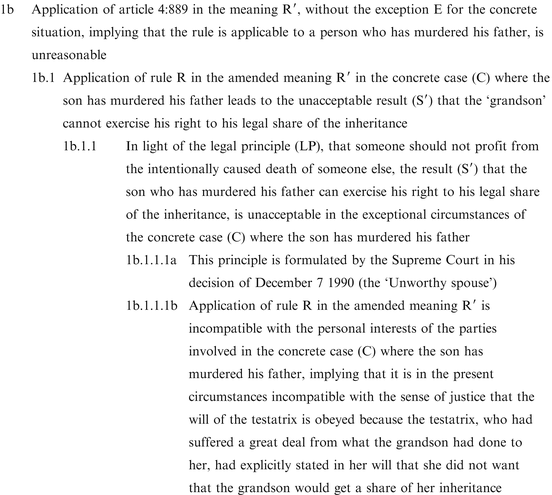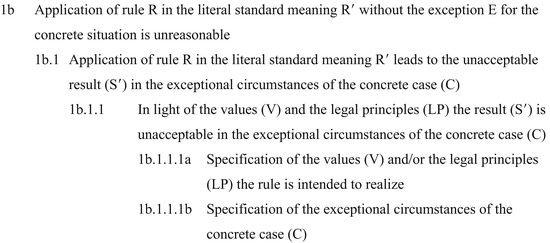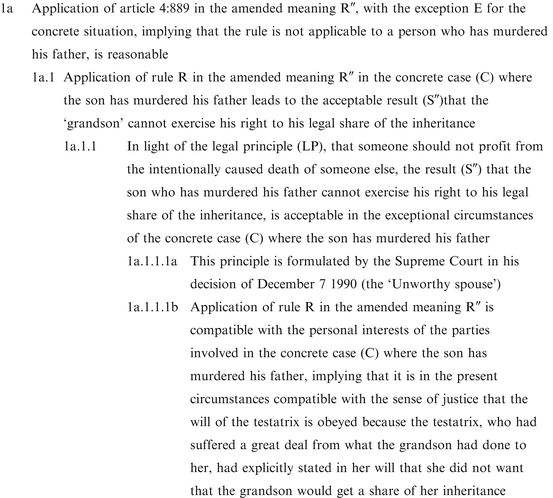Argumentation from Reasonableness in the Justification of Judicial Decisions


Fig. 11.1
Argumentation model for the rational reconstruction of argumentation from reasonableness
The first line of argumentation justifies the preference for standpoint 1a and the second line of argumentation justifies the rejection of standpoint 1b.
The argumentation is complex also in other respects because the argumentation must consist of different levels of subordinate argumentation that support each other.
On the first level (consisting of argument 1a.1 and 1b.1) the judge must justify that the preferred version of the rule (R″) leads to the acceptable result (S″) and the rejected version (R′) to the unacceptable result (S′). These arguments constitute a specific implementation of an argument from (acceptable and) unacceptable consequences/an argument from absurdity.
The argumentation of the second level (consisting of the argument 1a.1.1 and 1b.1.1) must justify the acceptability of result (S″) and the unacceptability of the result (S′) in relation to the relevant legal principles (LP) and values (V) and the exceptional circumstances of the case C.
The argumentation of the third level (consisting of 1a.1.1.1a and 1a.1.1.1b etc.) must specify the sources of the legal principles (LP) and values (V) as well as the exceptional circumstances of the concrete case C.
The argumentation on the second and third level forms the reconstruction of the intention of a rational legislator by specifying the principles and values that justify the exception in light of the circumstances of the a-typical case C.
This reconstruction of the argumentative obligations of a judge who uses an argument from reasonableness into an argumentation model clarifies his argumentative obligations. In this way the model serves as a heuristic tool for reconstructing the commitments of the judge that have been characterized in the literature as the ‘plurality of normative and factual considerations’. I have tried to implement the ‘reconstruction of the intention of a rational legislator/ratio legis’ in terms of a specific implementation of an argument from absurdity and I have translated what is in the literature called the ‘cancelling’ or ‘weighing and balancing’ into elements of an argumentation model that account for the preference for rule R″ with an exception to rule R′ without an exception for the concrete case. It serves as a critical tool also for assessing the quality of the argumentation by checking whether the necessary elements of the argumentation are represented and whether they can be considered acceptable from a legal point of view. Whether the arguments are acceptable from the material perspective depends on the criteria of acceptability in a specific field of law. In section (4) I give a specification of the implementation of the concept of ‘reasonableness’ in Dutch civil law and on the basis of this, in (5), I use the model to give an analysis of an example of the use of an argument from reasonableness and fairness in Dutch civil law.
11.4 The Use of Arguments from Reasonableness and Fairness in Dutch Civil Law
To do justice to the context-dependency of the concept of reasonableness in the context of legal justification, I concentrate on the role of reasonableness in a specific domain, civil law in the Netherlands. In civil law in the Netherlands reasonableness plays a central role as a mechanism for the correction of outcomes that would be unacceptable from the perspective of justice in a concrete case. First, in 4.1, I explain the relevant rules with respect to the use of norm of reasonableness. Then. in 4.2, I discuss a decision of the Dutch Supreme Court in which the criterion of reasonableness as a reason for making an exception is implemented for a specific case.
11.4.1 The ‘Derogating’ Function of Reasonableness in Dutch Civil Law
In Dutch civil law, in some cases an argument from reasonableness and fairness is an argument that is explicitly recognized as an acceptable argument by the legislator. On the basis of article 6:248, 2 of the Dutch Civil Code the judge has the authority to make an exception to a contractual provision on the basis of reasonableness and fairness if application of the provision would be unacceptable in the concrete circumstances:
2. A contractual provision that is valid between the creditor and the debtor on the basis of the law, a custom or a legal act, does not apply if this would be unacceptable from the perspective of the standards of reasonableness and fairness.
In book 3 of the Dutch Civil Code in the general article 12 the legislator specifies the factors that play a role in determining what can be considered as reasonable and fair:
When determining what reasonableness and fairness require, generally accepted legal principles, legal convictions that are generally accepted in the Netherlands, and social and personal interests in the concrete case, should be taken into account.
These articles specify when a judge is allowed to make an exception to a legal rule on the basis of reasonableness and fairness and they specify the considerations that are necessary to justify an exception to a legal rule.
In Dutch law, such a use of reasonableness and fairness is called the ‘derogating function’ of reasonableness and fairness because reasonableness is considered as a criterion that ‘derogates’ other considerations that would normally justify applying the rule if the conditions of application are fulfilled.
In Dutch law, in other cases a judge can make an exception also to a rule but he has a heavier ‘argumentative burden’ which is in line with the obligations I have described in the argumentation model in Sect. 11.3. He must explain why a strict application would lead to an unacceptable result by specifying why a strict application would be incompatible with certain legal principles and values underlying the relevant branch of law and why the circumstances of the concrete case are exceptional so that they justify an exception on the basis of these principles and values.
11.4.2 The Implementation of Reasonableness and Fairness in the Context of the Application of Article 248 Book 6 in a Concrete Case
After the introduction of article 6:248, 2 of the Dutch Civil Code the first case in which the Dutch Supreme Court gave a fundamental decision about the way in which reasonableness should be implemented for the circumstances of a specific case was in the context of a dispute in which the question was whether the relatives of victims of asbestos cancer (mesothelioma) have a claim against the employer when the legal limitation period of 30 years (as specified in article 3:310, 2 of the Dutch Civil Code) has lapsed, since this form of cancer manifests itself only after 20 years and results in death within a year.22
The decision was in the case against the Nederlandse Scheldegroep (Supreme Court, HR 28 April 2000, NJ 2000, 430). The Supreme Court ruled that an exception to the limitation period on the basis of reasonableness and fairness is, in principle, acceptable in exceptional cases.23 The court did not give a clear rule but formulated the ‘points of view’ that should be taken into account when evaluating the unacceptability of the limitation period of 30 years. According to the court, these are requirements that weigh heavy. The Supreme Court sent the case back to the Court of Appeals to give a decision on the basis of these points of view.
This is the only case in which the Supreme Court explicitly made an exception on the basis of reasonableness and fairness. In the two cases that followed this case (Eternit and Hertel), the Supreme Court gave a different decision. In the Eternit case because the limitation period had not yet lapsed so that article 3:310,2 was not applicable, in the Hertel case the Supreme Court sent the case back to the Court of Appeals that had to investigate the unacceptability of the term of limitation on the basis of the points of view.
In the first case of the Scheldegroup the Supreme Court specifies for a particular category of cases which conditions should be fulfilled in order to make an exception on the basis of reasonableness and fairness of article 6:2. In this way the Supreme Court implements the open norm: for cases in which the death of the employee is caused by the work with asbestos, on the basis of reasonableness and fairness it is justified to depart from the general rule about the limitation of 30 years. The Supreme Court formulates this implementation of the open norm of reasonableness as follows:
3.3.3 Whether, in cases as the present one, application of the limitation period of 30 years after the event on which the liability rests, is indeed unacceptable according to standards of reasonableness and fairness, should be evaluated by taking into account the circumstances of the concrete case. As points of view that should be mentioned by the judge in his evaluation the following can be mentioned:
(a)
whether it concerns the compensation for an injury/damage of property or for a disadvantage that does not concern an injury/damage of property, and
(b)
to what extent the victim or his relatives have recourse to a payment (uitkering) with respect to the injury/damage from another source;
(c)
the extent to which the defendant is responsible for the event;
(d)
to what extent the defendant, before the limitation period has lapsed, has taken into account or should have taken into account the possibility that he would be responsible for the damage;
(e)
whether the defendant still has the possibility to defend himself against the claim;
(f)
whether the liability is covered by an insurance;
(g)
whether, after the damage has been discovered, the plaintiff has made his claim about the liability within a reasonable term and whether a legal action has been started.
(Supreme Court, HR 28 April 2000, NJ 2000, 430) See also Supreme Court, HR 28 April 2000, NJ 2000, 431 and HR 20-10-2000, NJ 2001, 268
In this case the Supreme Court specified the points of view that should be taken into account when implementing the derogating function of ‘reasonableness and fairness’ in the context of article 6:248, 2 for cases that concern the limitation period for liability for the consequences of asbestos cancer. As became clear, the Supreme Court wanted to limit the criteria for application of article 6:248, 2 to this type of cases and did not want to commit itself to a more general formulation of criteria.
11.5 An Exemplary Analysis of Argumentation from Reasonableness in the Case of the ‘Unworthy Grandson’
To illustrate how the argumentation model can be used for the analysis, I will discuss a representative example of the way in which Dutch courts use the argument from reasonableness to justify the decision to correct the law in a specific case on the basis of reasonableness and fairness.
In the case that is called the ‘Unworthy Grandson’, the district court of Haarlem uses an argument from reasonableness and fairness to justify that in the case in which a grandson had killed his father, an exception should be made to the legal rule of article 4:889 of the Dutch Civil Code about the right of a heir to his legal part of the inheritance.24 The ‘unworthy grandson’ who had killed his father and the wife of his father (for which he has been convicted and imprisoned in Australia) claims his share in the inheritance of his grandmother. He claims to have a right to his share on the basis of article 4:889 of the Dutch Civil Code that gives a child as a substitute a right to the legal part of the inheritance of a deceased parent. However, the other inheritors contest this right. The district court of Haarlem rules that the grandson is not entitled to his father’s share in the inheritance. As a justification the court refers to the derogating function of reasonableness and fairness stating that ‘in light of the legal principle that someone should not profit from the intentionally caused death of someone else, the right of the grandson to exercise his right to his legal share of the inheritance on the basis of article 4:889 of the Dutch Civil Code would, according to the standards of reasonableness and fairness in the circumstances of this concrete case, lead to an unacceptable result’.25
The district court decides that article 4:889 of the Dutch Civil Code that gives a child as a substitute a right to the legal part of the inheritance of a deceased parent, is not applicable in the concrete case because it would lead to an unacceptable result from the perspective of the underlying principle regarding unworthiness in the law of inheritance.26 By making an exception on the basis of reasonableness, the court applies article 6:248, 2, referring to the decision of the Supreme Court in the case of the ‘Unworthy Spouse’ I discussed at the beginning, in which the court applied article 6:248 also to an a-typical case in the field of inheritance.
I will now discuss the analysis of the relevant parts of the decision on the basis of the argumentation model. You find the analysis in Fig. 11.2.




Fig. 11.2
Analysis of the argumentation in the case of the ‘Unworthy Grandson’